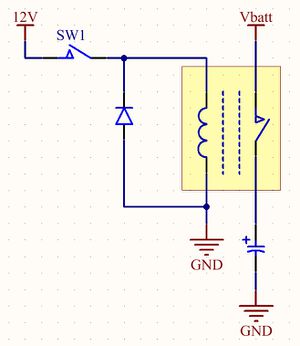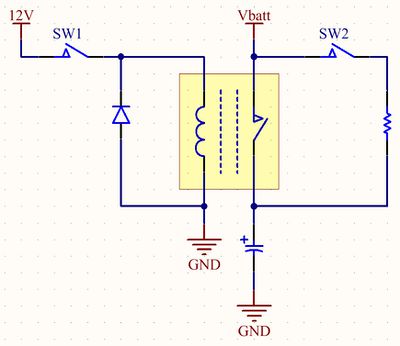Precharge Theory
From Unofficial Zero Manual
The following describes the precharge function of the BMS.
- Context
The attached circuit fragment shows the contactor in the yellow box, which consists of a control or coil side and an electrically isolated load or contact side.
- The dashed lines in the middle represent the electromagnetic core of the contactor.
- Coil Side
- SW1 is the controlling switch for the contactor, typically a transistor instead of a mechanical switch.
- When SW1 closes, it energizes the contactor core, pulling the armature of the contactor to close it.
- When SW1 opens, this magnetic field contains energy which must be safely dissipated to avoid destroying things with a large voltage spike.
- Usually the switch itself is what's destroyed.
- That's the function of the "flyback" or "kickback" diode shown.
- Load Side
- The capacitor shown is typically a very large value "bypass" capacitor which is needed as a reservoir for the battery current.
- It smooths out and quiets down the voltage transients on the high-power circuitry, which can be very severe when you're driving 500+ amps through an electric motor.
- Capacitors on your typical printed circuit board range in the sub-microfarad range to maybe a few microfarads, but in applications like this, bypass capacitors are almost always in the millifarad range or may even approach a farad.
- That's a ton of capacitance, designed with high-current wiring to handle hundreds of amps.
- The problem is when the capacitor is discharged, close to 0 volts, and the contactor is closed, full battery voltage essentially instantaneously applies to the circuit.
- That's a voltage difference between the battery and discharged capacitors of >100V, which results in a giant, fat blue spark inside the contactor just before the contacts close.
- That spark can easily represent enough energy to momentarily melt the contact material (copper), and as the contacts slap together, they cool rapidly and actually weld to each other.
- Needless to say, you do not want your contactor contacts welded together.
- Precharge Circuit
To prevent the damage described above, engineers add a power resistor and external switch around the load contacts, to "precharge" the bypass caps. See attached circuit fragment.
The resistor value varies, but a few hundred ohms is typical, and it does dissipate some heat (though only for a short time), so it's a bigger resistor than you'll find in most applications.
- On startup, SW2 is closed immediately.
- The inline resistor limits the current through it to a very small value, even when the capacitors are at a very different voltage than the battery.
- This prevents sparking damage to SW2.
- For several seconds, a charging current is applied through the resistor to the bypass capacitors. This is called precharging.
- When the voltages sensed across the contactor are close enough to avoid damage, SW1 activates contactor to close it.
- References
- Wikipedia Article on Pre-Charge
- New contactor, and coil suppression diode forum thread, by Doug S

